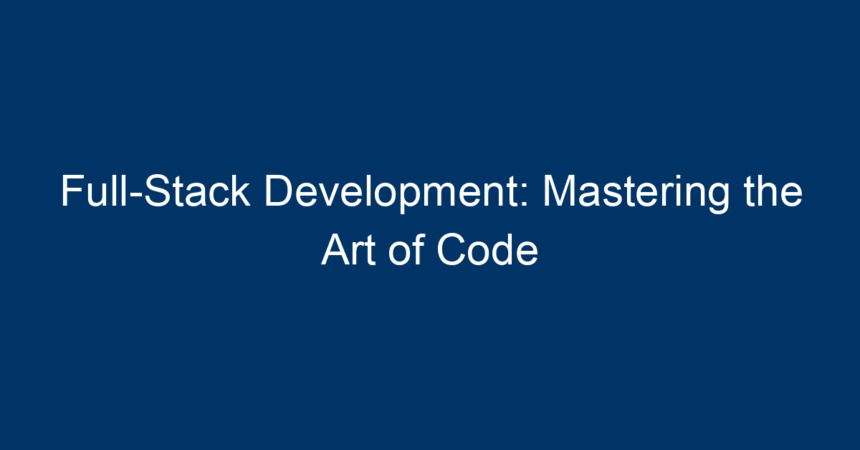Introduction
In today’s digital landscape, the demand for skilled developers continues to soar. Among the myriad of roles in the tech industry, full-stack development stands out for its versatility and comprehensive approach to building web applications. A full-stack developer possesses a blend of both front-end and back-end expertise, allowing them to oversee the entire software development process from conception to deployment. This article delves deeper into full-stack development, its significance, essential skills, tools required, and actionable strategies to master the art of code.
What is Full-Stack Development?
Full-stack development refers to the practice of working on both the front-end and back-end of web applications.
Front-End Development
The front end, often known as the client-side, involves everything that users interact with directly in their browsers. It includes:
- HTML: The backbone of web content.
- CSS: Styles and layout management.
- JavaScript: Adding interactivity and dynamic features.
Back-End Development
The back end, or server-side, deals with the underlying logic that powers applications. It handles:
- Databases: Storage and management of data.
- Server architecture: Hosting and processing requests.
- APIs: Enabling communication between the front end and back end.
Mastering both sides equips developers to build fully functional applications, facilitating better communication, faster problem-solving, and more cohesive solutions.
Why is Full-Stack Development Important?
Versatility
Full-stack developers are not pigeonholed into one domain. They can adapt and tackle various challenges, making them invaluable in any development team.
Increased Job Opportunities
With businesses increasingly preferring developers who can manage multiple aspects of projects, full-stack development skills enhance employability. According to industry trends, the demand for full-stack developers continues to rise, providing ample job opportunities.
Cost Efficiency for Companies
Employers benefit from hiring full-stack developers as they often save on costs associated with hiring multiple specialists. A single developer can manage several elements of a project, streamlining communication and enhancing productivity.
Essential Skills for Full-Stack Developers
To master full-stack development, one must cultivate a robust toolkit of skills:
1. Proficiency in Front-End Technologies
A solid understanding of languages like HTML, CSS, and JavaScript is essential. Familiarity with frameworks like React, Angular, or Vue.js can further enhance your front-end capabilities.
2. Server-Side Programming
Choose a language for back-end development, such as Python, Ruby, Java, or Node.js. Understanding frameworks associated with these languages (like Django for Python or Express for Node.js) can speed up development processes.
3. Database Management
Knowledge of databases, both SQL (like MySQL and PostgreSQL) and NoSQL (like MongoDB), is crucial for managing application data efficiently.
4. Version Control Systems
Familiarity with Git allows developers to manage code changes effectively. It’s essential for collaboration in today’s agile work environments.
5. Basic DevOps Practices
Understanding basic DevOps practices can improve deployment processes. Familiarize yourself with CI/CD (Continuous Integration/Continuous Deployment) tools for smoother transitions from development to production.
Tools and Technologies for Full-Stack Development
In the realm of full-stack development, various tools can simplify workflow and increase productivity:
Integrated Development Environments (IDEs)
- Visual Studio Code: Known for its versatility and rich plugin ecosystem.
- Atom: A customizable and hackable text editor suitable for web development.
Front-End Libraries and Frameworks
- React: A JavaScript library for building user interfaces.
- Bootstrap: A front-end framework for designing responsive websites quickly.
Back-End Frameworks
- Express.js: A minimal Node.js framework for building web applications.
- Ruby on Rails: A robust framework ideal for rapid application development.
Database Tools
- MySQL: A widely-used relational database management system.
- MongoDB: A NoSQL database that excels in handling large volumes of unstructured data.
Cloud Platforms
- AWS (Amazon Web Services): Provides a broad range of cloud computing services.
- Heroku: A platform for deploying and running applications in various programming languages.
Learning Path to Master Full-Stack Development
Step 1: Set Clear Goals
Define what you want to achieve. Whether it’s to land a full-time job as a full-stack developer or to build a personal project, having clear goals will guide your learning.
Step 2: Start with Front-End Development
Begin by mastering HTML, CSS, and JavaScript. Create small projects to apply your knowledge and build your portfolio.
Step 3: Learn Back-End Fundamentals
Choose a language and framework to start with. Understand how to create basic APIs and connect to databases.
Step 4: Work on Full Projects
Combine your front-end and back-end skills to develop full-fledged applications. Use tools like Git for version control and project management tools for keeping track of your work.
Step 5: Collaborate and Seek Feedback
Join online communities or local meetups to collaborate with other developers. Platforms like GitHub allow you to share your work and gather feedback.
Step 6: Stay Updated and Keep Learning
The tech landscape is ever-evolving. Follow industry blogs, take online courses, and participate in hackathons to keep your skills sharp.
Challenges in Full-Stack Development
While the journey to becoming a full-stack developer is rewarding, it can also be challenging:
-
Keeping Up with Technologies: The rapid pace of change in frameworks and libraries can be overwhelming.
-
Balancing Skills: Mastering both front-end and back-end skills requires time and dedication.
- Real-World Experience: Gaining practical experience through projects can be difficult without real-world opportunities.
Conclusion
Mastering the art of code through full-stack development opens doors to a myriad of opportunities in the tech industry. By acquiring essential skills, utilizing the right tools, and following a structured learning path, you can position yourself as a proficient full-stack developer.
Actionable Insights:
- Create a Portfolio: Showcase your full-stack projects to potential employers.
- Network: Connect with other developers through forums, LinkedIn, and meetups.
- Contribute to Open Source: Gain real-world experience and improve your coding skills.
- Seta Regular Learning Schedule: Dedicate time each week to learning new technologies and frameworks.
By embracing these strategies, you’ll not only enhance your full-stack development skills but also thrive in an exciting and ever-evolving field. Start your journey today, and master the art of code!




